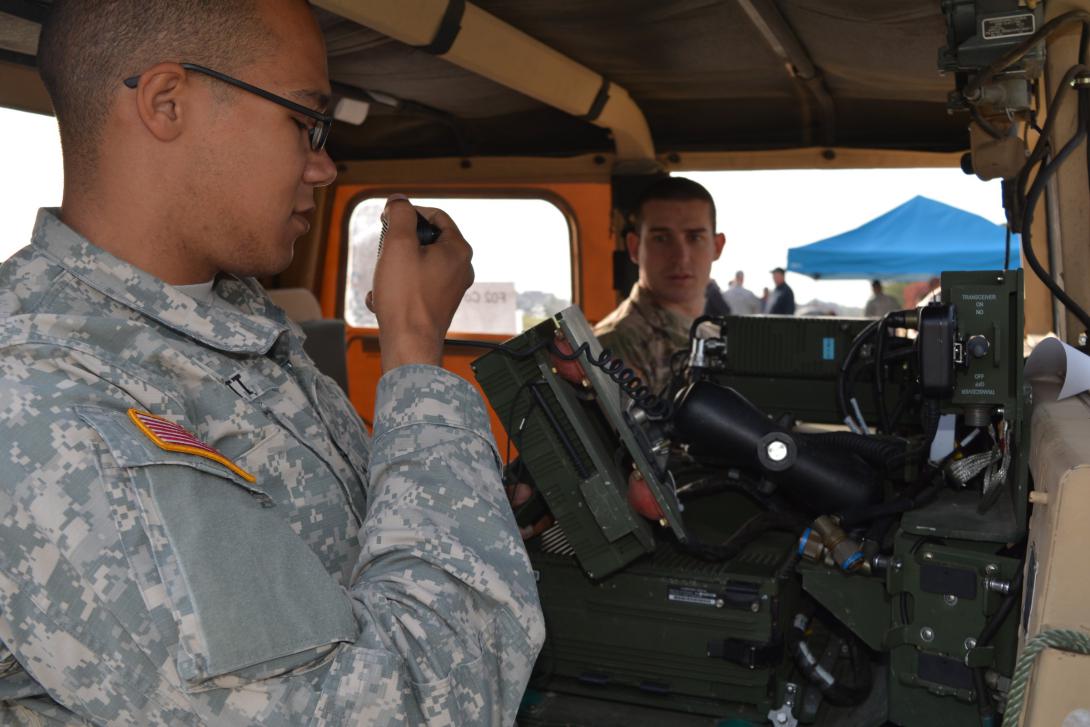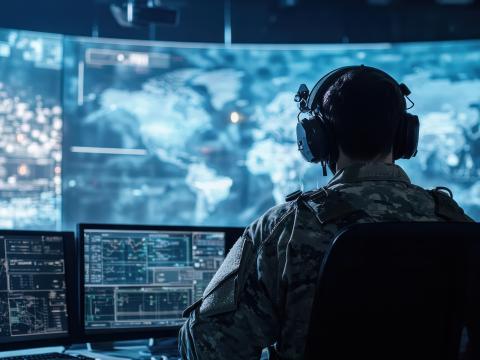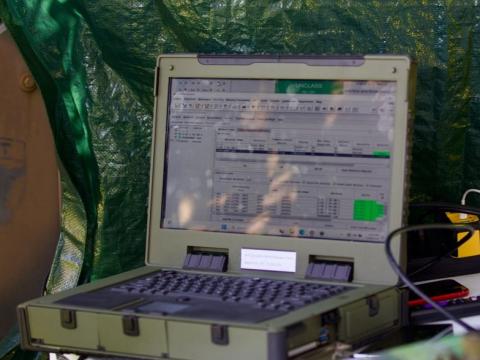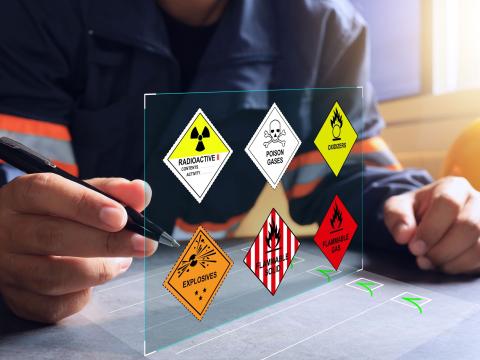For Army C3, Better Also Must Be Simpler
As the U.S. Army brings even more advanced information technologies into the force, the service also strives to simplify training and use of these highly capable tools. Making increasingly complex systems simpler to operate now is a core function of the office tasked with designing, fielding and maintaining command, control and communications in the warfighting realm.
This issue encompasses two elements of the activities being undertaken by the Program Executive Office for Command, Control and Communications–Tactical (PEO C3T). The hope is for users to learn how to operate systems more quickly and to get systems up and running in the field faster. However, the growing complexity of new commercial capabilities entering the force hinders efforts to streamline operations.
“Getting these systems simpler to operate and less of a burden is more important than significant advancements in capability,” declares Gary P. Martin, PEO C3T. “The rapid pace of technology causes the requirements community to want more quicker. In the end, the user wants to be able to effectively command and control. Taking the capabilities we’re delivering today and reducing the complexity for operations maintenance and initialization is more important than adding significant enhancements to that capability.”
Complicating matters, though, is that the capabilities recruits bring to the Army define what they expect when they join the service, Martin says. Constraints in the tactical space are very different from what these new soldiers might have experienced in the commercial marketplace. “There’s a yin-yang kind of push-pull there that is driving the requirements community to figure out how to balance what is useful capability, operationally and tactically, and what is minimally required,” he explains. “I think we’re going to struggle with that for some time.”
The sheer speed of technological change adds to the struggle. Martin reflects on the development of the Army’s first digital division more than a dozen years ago at Fort Hood in Texas. What then was a significant revolution is “child’s play” compared with what the Army is fielding today, he states. “The scope and scale of what capability that we are delivering as part of capability set fieldings significantly outweigh the capability that we were delivering back in the first digital division,” he says.
Modernizing capability set fieldings is one of the biggest challenges facing the PEO C3T, Martin allows. A brigade fielding alone comprises the Warfighter Information Network–Tactical (WIN-T) Increment 2, digital radios and the new version of Joint Battle Command–Platform (JBC-P), the Army’s next-generation blue force tracking system. “It is a fairly significant undertaking to go into a unit and provide a significant modernization package to them,” he says. “One of our challenges is the pace that these units are being tagged for operational readiness requirements. So, it is very challenging for us to be able to take a unit offline, go in and issue and install all the new equipment, conduct all the new equipment training and then get them proficient with the new kit prior to their operational readiness and employment.”
The office’s challenge in turn manifests itself in the unit’s ability to gain and build proficiency on the entire kit provided to it, he continues. As a result, home station training has become a major focus for the signal community as well as for other disciplines. Also, some of the equipment being fielded is so new to the Army that it is not yet “in the schoolhouses” where soldiers are trained, so even troops with specialized training are seeing their gear for the first time when they join their units.
“There is a high probability that new soldiers coming in, who were not there for new equipment training, never see this equipment until they get to the unit,” Martin states. “So now there is a burden on the unit to try to take a large number of soldiers, who may have rotated in during summer, and train them at home station because [PEO C3T] has moved on at that point to the next fielding location.”
About two years ago, the PEO C3T began collecting data at its combined training centers from all the rotations. Units still rely heavily on technical assistance, Martin notes, and this information was amassed and sorted by trouble ticket, system, issue and resolution. Reviewing a year’s worth of this data revealed that many issues were training-related. Units had not become proficient in the employment of their systems despite being taught the necessary technical skills.
Martin relates that the office has taken that feedback to the mission command training centers at posts, camps and stations. It also has worked to improve instruction with the Army’s Training and Doctrine Command (TRADOC), Forces Command (FORSCOM) and Communications-Electronics Command (CECOM) and the 11 universities that provide sustainment training for transmission systems such as WIN-T. Enhanced training ensures that instructors are tracking the new capabilities being fielded as well as any recurring problems that pop up.
Ultimately, the goal is a system soldiers would not need to train on, Martin offers. This type of system would be so intuitive that users would not have to spend time training in garrison to maintain proficiency. The office has focused its simplification efforts on operating the network, which tends to be more complicated than operating devices. In WIN-T, for example, the operator interface on the soldier node extensions—the satellite terminal integrated into the commander’s vehicle—has been greatly improved. Working with the contractor, the office streamlined the menus from 12 to a single “switch on, hit a button and acquire a satellite” mode, Martin says.
Other efforts underway in network operations, or net ops, greatly simplify the tasks associated with initializing systems such as WIN-T, command post hardware and tactical radios, he continues. These efforts literally unburden soldiers, lightening their load, among other benefits, he says. One system being deployed will automate the scripts for getting command post servers up and running into a known baseline without substantial operator interaction. This will reduce the time it takes to “configure the talk” for mission command systems by an order of magnitude, Martin declares. “It unburdens users from all the time and effort it takes to get these networks up and operational,” he emphasizes.
One new initiative would generate a next-generation tactical command post. The PEO C3T is working with other Army commands and actual divisions to prototype mobile command post capabilities. Two technologies have shown significant progress. One is secure Wi-Fi, which would eliminate the need for large-scale wiring within command posts. This would reduce the logistics burden along with the setup and breakdown time. The other technology, involving virtualization, would cut the time to initialize command post capabilities from 72 hours to just a few hours. Martin emphasizes the importance of this improvement for early entry deployment.
Future programs are likely to fall into two categories. One aims to keep pace with technology by implementing common computing devices. Martin observes how digital computing capability is advancing significantly as a result of investments in the commercial marketplace. The PEO C3T will exploit these investments by driving toward common digital computing platforms to take advantage of solution convergence instead of relying on multiple computers to control and manage operations for separate systems.
Martin offers the example of recently fielded multichannel-capable Manpack units with satellite communications (SATCOM) and Single Channel Ground and Airborne Radio System (SINCGARS) capabilities. Soldiers found these units to be heavy and large consumers of power that grew uncomfortably warm, he reports. The next-generation unit, for which three vendors are competing to supply, will be at least 3 pounds lighter and consume less power. “We simply are taking advantage of the evolution of the computing capability in the commercial marketplace and rolling that into our products,” Martin warrants.
The other program category involves capability virtualization. This already is enhancing the office’s ability to reduce the size of capabilities that are delivered to the force. For example, when the PEO C3T fielded WIN-T Increment 2 to three Stryker brigade combat teams, it had to remove two seats from the platform to fit the computing hardware. The next Stryker integration will return the seats to the vehicles and place the components in a compact configuration, Martin says. He points out that today’s ability to virtualize firewalls, routers and other technologies that used to be discrete components has allowed the office to reduce that logistics footprint by more than two-thirds. Virtualization also reduces power consumption significantly.
The office is making other WIN-T adjustments as well. Martin continues that many net ops systems serving as WIN-T backbone hubs are mounted on medium tactical wheeled vehicles, which does not aid their deployment in the Global Response Force. Next spring, the office will test moving all that net ops capability onto Humvees. “By this time next year, the 82nd Airborne Division will be able to deploy with its entire WIN-T system onto roll-on/roll-off capability on aircraft,” Martin predicts. This is important for early entry capabilities, he says.
In addition to refining and streamlining technologies, the office is finding better ways to patch security vulnerabilities in commercial products. With the Army’s growing use of commercial hardware and tools, cybersecurity is becoming a joint effort between the service and the private sector. Being able to patch vulnerabilities in commercial products when they appear is a problem, Martin admits. If a unit is deployed and operational, then its systems are on the network and it is easier to patch them. If a unit is in garrison, then its systems are in storage, and their commercial software products will require a significant amount of patching when they are reactivated. The office is working with the Army Network Enterprise Technology Command (NETCOM), FORSCOM and CECOM to simplify the patching process for the unit—perhaps providing all the patches from a common server, Martin suggests.
Another approach is to automate the patching process using commercial tools. The office also is working to enable a commander to scan a tactical network in garrison to learn if its patches are up to date.
Additionally, ensuring user authentication is about to change. Currently, manual password entries are the means of verification, but this process is fraught with human error. Martin affirms that the office has begun the engineering work for applying tactical public key infrastructure on Army systems. The service would transition to certificate management and key identification for individuals, which would eliminate the need for manual password entry. Issues include the token and updating secret Internet protocol router (SIPR) certificates if they are lost, which the office is working on with the Army’s chief information officer/G-6 and others.
The tactical network backbone, which is where routers, firewalls and intrusion detection systems reside, also is undergoing a security change. Martin says the office is enhancing its ability to integrate new capabilities such as virtual firewalls.







Comments